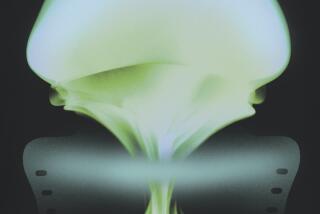From the Archives: ‘Independence Day’ revives a genre that has slept with the fishes since the 1950s
- Share via
With “Independence Day: Resurgence” now in theaters, revisit the first invasion in The Times’ original review of “Independence Day,” which opened in theaters July 3, 1996.
“Independence Day” is the Hollywood version of raising the dead. Its frankly spectacular special effects revive a genre that has slept with the fishes since the 1950s, the “Keep watching the skies” epics of destructive alien invasion.
Based in spirit on “The War of the Worlds,” H.G. Wells’ tale of marauding Martians (which also inspired Orson Welles’ famous radio broadcast and a 1953 George Pal production), “Independence Day” does more than just lift situations and character types from those long-neglected films.
In an act as astonishing in its own way as the visual wonders, “ID4,” as it’s come to be known, has consciously duplicated the cornball dramatic sensibility of those lost days. This is not a 1990s version of a 1950s movie, this is a 1950s movie, period, the kind of fatuous production “Mystery Science Theater 3000” was created to parody, enlivened with the mind-bending effects only a $70-million budget can procure.
See more of our top Entertainment stories on Facebook »
With a script co-written by the “Stargate” team of director Roland Emmerich and producer Dean Devlin, “ID4” proceeds to marry schlocky plot elements to a cheerful insistence on stereotyping, among others, Jews, gays, alcoholics, scientists and residents of Los Angeles, presented as the only people on the planet too blissed out to see the coming invasion as a threat. Spending a scant four weeks on script versus 13 months on physical production, as happened here, does have its drawbacks.
On the other hand, “ID4’s” addiction to cardboard characters, however oblivious it is to its own naivete, has a kind of adolescent charm. And the film’s effects work--about 50 minutes worth--is exceptionally impressive, including extensive use of models, vivid computer-generated imagery and even a pyrotechnics squad. At the same time, some of “ID4’s” most impressive images involve a concept as basic and uncomplicated as a shadow.
Because it is the enormous, terrifying shadows the invaders cast that are glimpsed first. Dozens of spaceships, each with a width of more than three miles, take up positions over the world’s major cities, and “ID4” does an excellent job conveying the boggling immensity of these extraterrestrial vehicles.
Set over three days starting July 2, the film follows a handful of people (who naturally keep bumping into one another) as they react to the crisis. At the top of the chain of command is President Whitmore (Bill Pullman), a former fighter pilot especially worried because his wife, Marilyn (Mary McDonnell), is out of town.
Also worried, but for a different reason, is David Levinson (Jeff Goldblum), a New York techno-wizard who breaks the aliens’ code and realizes that their intentions are not the best. Although he’s only a humble cable guy, David just happens to have an ex-wife (Margaret Colin) who is the president’s communications director, so off he heads for the White House.
Unfortunately, David takes father Julius (Judd Hirsch) with him, a package of oy vey cliches so embarrassing the film would have been better off with Eddie Murphy (whose repertory includes a convincing old Jewish man) in the role.
Offering still more awkward comic relief is Russell (Randy Quaid), an alcoholic crop duster pilot who claims aliens abducted him for nefarious experimentation a while back. Russell’s good old buddies are dubious, but guess who’s going to laugh last.
“ID4’s” final, and most successful, plot strand involves Marine fighter pilot Capt. Steven Hiller, played by Will Smith. Irritated by his inability to make astronaut and uncertain about whether to marry his exotic dancer girlfriend Jasmine (Vivica Fox), Smith’s character is the film’s most satisfying. It’s to Devlin and Emmerich’s credit that they consciously went after an African American for their action hero, and it is nice to see how well that move paid off.
Although it’s good at conveying the panic in the streets when the aliens appear, “Independence Day’s” best moments are when the invaders attack. Cities engulfed by rolling walls of flame, sinister aquamarine power blasts turning beloved national monuments to toast, even the roiling clouds the spaceships appear out of, they are all disturbing, unsettling and completely convincing. And because director Emmerich never lingers over scenes, “ID4” plays more quickly than its nearly 2 1/2-hour length would indicate.
Safe on Air Force One thanks to David’s warning when the chaos erupts, the president starts to wonder who the bad guys are and why they flew 90 billion light-years to pick a fight. In answering these questions, “ID4” hooks into a familiar paranoid fantasy of the tabloid set concerning a previous alien shipwreck and cover-up centering on Roswell, N.M.
This borrowed quality infects all of “Independence Day’s” dramatic sequences, with riffs lifted from sources as diverse as “Alien” and “Dr. Strangelove.” Even the film’s eventual tribute to the brotherhood of nations under duress feels terribly second-hand. In fact so much about “ID4” is so old it’s inevitable that homesick audiences, eager for familiar scenarios, will embrace it as if it’s nothing but new.
MORE REVIEWS FROM THE ARCHIVES:
‘Star Wars’ hails the once and future space western
The Times’ original 1985 review of ‘Back to the Future’: We really hated it
Steven Spielberg’s “Jaws” was harpooned by the Los Angeles Times on many levels
More to Read
Only good movies
Get the Indie Focus newsletter, Mark Olsen's weekly guide to the world of cinema.
You may occasionally receive promotional content from the Los Angeles Times.











